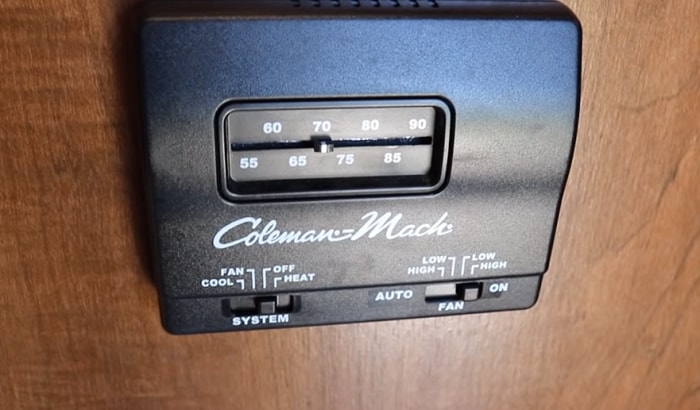As your home away from home, comfort is one of the vital things your RV can offer you and having a working thermostat is part of its capacity to bring you some comfort even while having your great outdoor adventure.
After all, a thermostat is a part of what regulates the temperature inside your RV, keeping everything just right in terms of the interior condition. Aside from this, it’s also important that your thermostat is in proper working order because this will help it be more energy-efficient and allow you to save on operational costs.
With that said, you need to know how to tell if the RV thermostat is bad so you can know how to fix them. So, what are the common issues RV thermostats face and how can you tell? Moreover, what can you do about them?
Table of Contents
Common Issue #1: Power
The issues:
- The system won’t boot up.
- The thermostat display won’t respond or doesn’t have a display.
- The display is too dim.
Troubleshooting:
1. Check your thermostat for any physical damages.
This is usually the first reason why your thermostat isn’t working properly. If you find major damages, then it might be time to call someone to repair it or if it’s beyond repair, replace it. If it’s minor or there aren’t any signs of damages, then proceed to the next step.
2. Replace the batteries of your thermostat (if it has them).
More often than not, replacing the batteries would be enough to resolve the power issue. However, if you did so but the problem/s persists, then it’s time to proceed to the next step.
3. Check your thermostat’s wiring.
First things first though, if you have no experience with tinkering with anything electrical, then it might be best to call a professional to handle this as it may result in accidents or injuries. After all, this deals with electrical components and it might result in even larger and worse damages if not dealt with properly.
If you’re an electrician or have sufficient expertise when it comes to tinkering with electrical components, then you may proceed with this step. Take the necessary safety precautions when dealing with the circuitry to avoid any accidents and/or injuries.
With this step, you need to check for any irregularities like loose, fried, cut, or exposed wires. You can tighten loose wires and replace and/or repair damaged ones.
4. If none of the above steps work, hire a professional or replace it.
If the display and the power are responsive enough, then the problem lies with the system itself which needs to be dealt with by an expert.
Common Issue #2: Temperature
The issues:
- The unit won’t heat/cool the room properly or at all.
- The thermostat’s displayed temperature doesn’t change.
- Displayed temperature and the actual temperature felt are different.
- The temperature felt cannot be sustained/ often changes drastically.
Troubleshooting:
1. Avoid exposing the thermostat unit to external factors.
Things like external temperature, sunlight, etc. can affect the interior temperature of your RV, making it cooler or warmer than your set temperature.
2. Tighten loose wires.
The changes in temperature can also be caused by power issues like loose wires so if you’re experiencing drastic changes, then it might be due to this. However, only tinker with the wiring if you know how to do so.
3. Calibrate your thermostat’s temperature.
To calibrate, you first need to set the temperature to cold, then normal, then warm. Do this at an interval of 10 minutes each, with 5 degrees in between. Reboot your thermostat after doing this. If there are no changes, proceed to the next one.
4. Replace your thermostat or hire someone.
If there are still problems with your thermostat’s temperature, then it might be time to hire someone or replace the system altogether. Do whichever is more feasible for you.
Common Issue #3: Display Response
The issues:
- The system won’t boot up or shut down.
- The display is responsive, but the system won’t shut down.
- The A/C system keeps running even after being shut down.
Troubleshooting:
1. Check your wiring for irregularities or damages.
Again, only do this if you’re experienced or knowledgeable enough about dealing with electrical components. This is to avoid accidents and/or injuries resulting from improper handling. If there are loose wires, tighten them and have them repaired if damaged.
2. If the problem persists, hire a professional.
If the wiring seems fine but the problem persists, then it might be something more complex that requires the expertise of professionals.
Conclusion
Having well-regulated interior temperature in your RV can only be possible with a properly working thermostat. Highlighted above are some of the common issues that can affect the performance of your RV’s thermostat. You can also learn more about RV air conditioner and how cold should an RV air conditioner get. They will come in handy for your travels.
Knowing how to tell if RV thermostat is bad can help you identify the problem and take the necessary steps to repair it – or replace it if needed.
If you enjoyed the article, please feel free to share with your family and friends and don’t forget to leave a comment letting me know what you think.

Hi, I am Tom Hank, an RV-er since 2014. Back then, I started without much help. As you can imagine, the struggles are endless. But now, you do not have to begin your adventures knowing next to nothing about RV lives.





